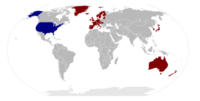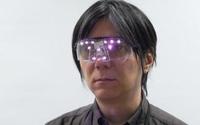-
Lawmakers want to ease travel to U.S. as part of immigration legislation

A bi-partisan group of House lawmakers is working to include a provision in the House immigration legislation which will make it easier to travel to the United States. Travel industry groups support the effort, having fought for years to get the government to relax security measures. The industry has argued that these measures have turned off many foreigners from traveling to the United States.
-
-
HID Global selected as prime contractor for USCIS Green Card
Irvine, California-based HID Global the other day announced the U.S. Citizenship and Immigration Services (USCIS), an agency of the U.S. Department of Homeland Security, has selected the company as the prime contractor for the USCIS Permanent Resident Card, commonly known as the Green Card.
-
-
Webcast of Forensic Handwriting Analysis Conference available online
On 4-5 June 2013 NIST and partnering organizations hosted the Measurement Science and Standards in Forensic Handwriting Analysis Conference. In case you missed this event or would like to view/listen again to the presentations, the archived video of the Webcast is now available online.
-
-
Divided Supreme Court allows collection of DNA samples from suspects upon arrest
The Supreme Court on Monday, in a 5-4 decision, ruled that law enforcement is now allowed to take samples of DNA from people who have been arrested on suspicion of committing a serious crime.“Taking and analyzing a cheek swab of the arrestee’s DNA is, like fingerprinting and photographing, a legitimate police booking procedure that is reasonable under the Fourth Amendment,”Justice Anthony Kennedy wrote for the majority.
-
-
Biometric technology identifies one of the Boston Marathon bombers
In a study which evaluated some of the latest in automatic facial recognition technology, researchers were able quickly to identify one of the Boston Marathon bombing suspects from law enforcement video, an experiment that demonstrated the value of such technology.
-
-
Interoperability for automated fingerprint ID systems
A new set of publications from the National Institute of Standards and Technology (NIST) could make it easier, faster, and most importantly, more reliable, for forensic examiners to match a set of fingerprints with those on file in any database, whether local, state, or national.
-
-
More state commit to compliance with REAL ID
DHS reports that six more states have become complaint with the REAL ID Act, meaning that the act is finally making some headway after eight years of debating and delays. Nineteen states are now in compliance with the Act, and twenty-six more have committed to meet the standards before the deadline. The Act, passed in 2005, had an original compliance deadline of 2008, but that deadline has been extended several times, and is now 1 December 2014.
-
-
Iowa implements Real ID act, but other states hold firm in opposition
Last month Iowa joined other states in implementing the REAL ID Act, which Congress passed in 2005 in an effort to combat terrorism in the aftermath of 9/11. The intense debate over the act continues, though: twenty-five states have passed resolutions rejecting REAL ID, with fifteen of them going as far as to make it illegal to comply with the act.
-
-
DNA sequencing a serious risk to privacy
The growing ease of DNA sequencing has led to enormous advancements in the scientific field. Through extensive networked databases, researchers can access genetic information to gain valuable knowledge about causative and preventative factors for disease, and identify new targets for future treatments. The wider availability of such information, however, also has a significant downside — the risk of revealing personal information. New study finds that new policies are needed to safeguard participants’ identity in genetic studies.
-
-
Biometric workshop studied voice, dental, oral standards
The National Institute of Standards and Technology (NIST) hosted a workshop to discuss proposed supplements to the biometric data format standard that support voice recognition, dental and oral data, disaster victim identification, and special data needs for mobile ID applications.
-
-
New imaging technique for identifying the age and sex of a corpse
Researchers have developed a new technique for identifying the age and sex of a corpse. It is based on a computing system which relies on free software, and has a reliability of 95 percent.
-
-
Thwarting facial-recognition, photo-tagging software

Information about when and where photographed subjects were when their pictures were taken is readily disclosed through photos taken, and the information is disclosed and distributed without their permission. The problem has become even worse due to the popularization of portable terminals with built-in cameras and developments in SNS and image search technologies. Japanese researchers offer a solution: goggles or glasses which, when equipped with near-infrared LED emitter. :
-
-
Feds to fund DNA collection from suspects
Wisconsin governor Scott Walker has revealed a plan to collect DNA from suspects upon arrest, and while Republicans who support the plan look for ways to fund it, some of the money could come from Congress.
-
-
Instant DNA analysis worries privacy advocates
In the past, it took weeks to analyze a person’s DNA, but with new technology it can take less than a day, and in most cases less than two hours; Rapid DNA analyzers can process a DN sample in less than ninety minutes; these machines, the size of a household printer, are now being marketed to local, state, and federal law enforcement agencies around the country; privacy advocates worry
-
-
U.K. political activist enters U.S. using a friend’s passport
Stephen Lennon, the 30-year old leader of the English Defense League, a street protest group active in organizing demonstrations against what group members regard as the growing influence of Islam in British life, was sentenced to ten months in jail for using a friend’s passport to enter the United States
-
- All
- Regional
- Water
- Biometrics
- Borders/Immig
- Business
- Cybersecurity
- Detection
- Disasters
- Government
- Infrastructure
- International
- Public health
- Public Safety
- Communication interoperabillity
- Emergency services
- Emergency medical services
- Fire
- First response
- IEDs
- Law Enforcement
- Law Enforcement Technology
- Military technology
- Nonlethal weapons
- Nuclear weapons
- Personal protection equipment
- Police
- Notification /alert systems
- Situational awareness
- Weapons systems
- Sci-Tech
- Sector Reports
- Surveillance
- Transportation
Advertising & Marketing: advertise@newswirepubs.com
Editorial: editor@newswirepubs.com
General: info@newswirepubs.com
2010-2011 © News Wire Publications, LLC News Wire Publications, LLC
220 Old Country Road | Suite 200 | Mineola | New York | 11501
Permissions and Policies
Editorial: editor@newswirepubs.com
General: info@newswirepubs.com
2010-2011 © News Wire Publications, LLC News Wire Publications, LLC
220 Old Country Road | Suite 200 | Mineola | New York | 11501
Permissions and Policies
